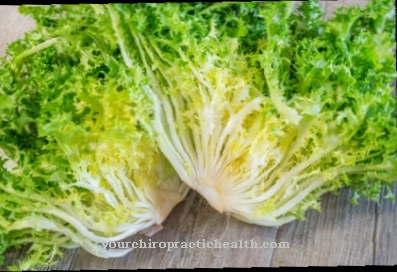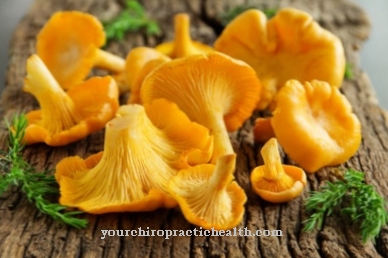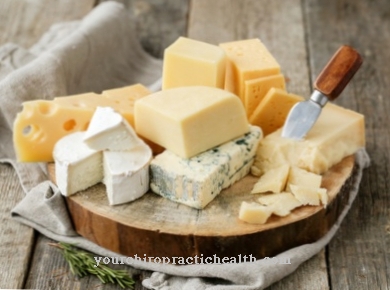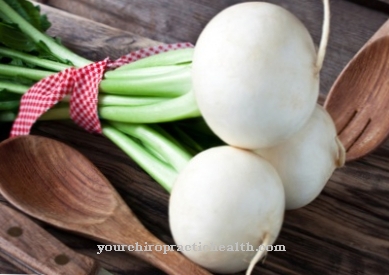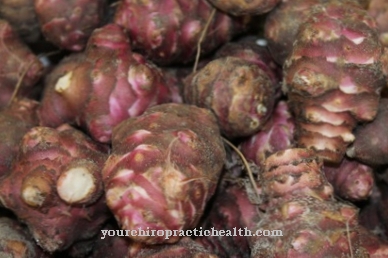The Kidney beanAlso called the green bean, is not only a well-known vegetable but also an ancient remedy. It has a variety of effects on human health. Many physical complaints can be alleviated with simple teas made from haricot pods or the consumption of steamed or briefly cooked beans.
What you should know about the kidney bean

The kidney bean originally comes from South America. The oldest archaeological evidence of its existence there comes from a Peruvian cave from around 6,000 BC. The ancestor of the common bean is probably the wild variety Phaseolus aborigineus.
The Aztecs and Incas already used their seeds and fruits for medicinal purposes. From there, the vegetable plant came to North America. It has been found in Europe since the 16th century. Today they can be found in almost every country in the world. The bean belongs to the legume family (Fabaceae). Phaseolus vulgaris is an annual plant that occurs in two species in this country. Both have triple leaves and shoots growing laterally from the leaf axils. The runner bean winds up to a height of 4 meters on a climbing aid.
The Broad bean forms only small bushes about 60 cm high. The yellowish, white or purple 2 cm large flowers are arranged alternately and are clustered together. The fruits of the kidney bean usually have green pods 5 to 25 cm in length. They contain kidney-shaped seeds that are mostly white but also brownish. The pods are harvested in autumn and dried in the sun without seeds.
Importance to health
Haricot beans have a beneficial effect on health. They can be used to treat various diseases, but also for prevention. Bean pods are weakly diuretic and can therefore eliminate urinary tract infections, urinary stones and urinary gravel.
The pathogens and the mineral salts are simply excreted renally. In addition, the pod ingredients are also helpful with gout. The inflammable substances are discharged as quickly as possible. For use as a diuretic, the kidney bean received a positive rating from Commission E. A tea made from bean pods also has a blood sugar lowering effect: haricot beans have a low glycemic index and only cause the blood sugar level to rise slightly after a meal. Therefore, they are suitable for the prevention of type 2 diabetes. In order to reduce the high cholesterol level, the patient consumes half a cup of prepared beans daily as a cure for several weeks.
Taking 70 ml of haricot and pod juice daily for 3 weeks helps against rheumatic diseases. The flavonoids contained in the vegetables prevent the platelets from clumping together in the blood and the oxidation of cholesterol. In this way, the risk of thrombosis can be reduced and the occurrence of arteriosclerosis can be prevented in advance. Thanks to the high proportion of digestive fiber in the bean pods, carcinogenic substances are quickly removed through the stool. The same thing happens with excess cholesterol. This lowers the blood fat level. The antioxidant substances in the bean pods neutralize the dangerous free radicals that cause the cells to degenerate into cancer cells and can even protect the cell's own DNA from oxidative damage.
In addition, the user can effectively relieve skin diseases (eczema, itching, rashes), heart diseases, sciatica, dropsy and edema, albuminuria (protein excretion in the urine) and liver diseases with haricot beans. To do this, he simply takes the appropriate agent in the prescribed dosage for at least several weeks. Haricot pods can also support a weight loss diet because they are low in calories and make you feel very full. 40 g of dried bean pods are boiled for 10 minutes with 1 liter of water and left to steep for 45 minutes.
After straining, the patient will drink 5 large cups daily for 10 days if they have albuminuria. For normal applications (dehydration, diabetes), 1 tablespoon of pods per 150 ml of water is sufficient. After 15 minutes, the filtered tea is drunk 2 to 3 times a day.
Ingredients & nutritional values
| Nutritional information | Amount per 100 gram |
| Calories 31 | Fat content 0.1 g |
| cholesterol 0 mg | sodium 6 mg |
| potassium 209 mg | carbohydrates 7 g |
| Fiber 3.4 g | protein 1.8 g |
Because of its high protein content (20%) it is also known as a protein plant. Therefore, it is one of the most important staple foods in Central and South America.
Haricot pods contain amino acids such as arginine, flavonoids, silica, chromium salts, hemicellulose, trigonelline, asparagine, lysine, choline, tyrosine, monoamino fatty acids, phaseolin, phaseoloside A, triterpene triglucoside, beta-carotene, vitamins B2, B6, C, E , Folic acid, calcium, potassium, magnesium and iron. Haricot beans are used medicinally in the form of dried pods without seeds (5 to 15 g daily), standardized finished medicinal products (extract) and the homeopathic phaseolus vulgaris made from the whole fresh bean plant (globules, dilution, tablets) for the indication of cardiac insufficiency.
Intolerances & allergies
Green beans should not be consumed raw as they contain high amounts of the toxic lectin phaseolin. It is best to boil them up briefly or to steam them. Then the active substances are also almost completely present. If consumed raw, symptoms of intoxication such as vomiting, diarrhea, cramps, shock and hypokalemia can occur.
In people with a bean allergy, physical contact with the pods can cause dermatitis. Diabetics should only use medicinal bean applications in consultation with their doctor. The lowering of blood sugar may make it necessary to adjust the insulin dose. People with low blood pressure should only consume bean products in small quantities. In some people, taking kidney beans causes increased gas build-up in the intestines. To alleviate the symptoms, it is advisable to consume fennel or caraway seeds together with the beans. They relax the intestinal muscles.
Shopping & kitchen tips
The kidney bean is available regionally in Germany from June to October. However, kidney beans can be frozen for up to 12 months, so they can still be enjoyed in winter. Small tender specimens with a maximum length of ten cm should preferably be used for freezing. Before the beans end up in the freezer, it is recommended that they be blanched for two to three minutes.
Basically, beans should not be consumed raw, as the poisonous phasin can cause stomach pain and inflammation. Cooking neutralizes the phasin's toxic effects. Before cooking or cooking, the beans are washed and any threads removed, then they cook in hot water for between 15 and 40 minutes. So that the green beans do not lose their beautiful green color, they are frightened with plenty of cold water after cooking and only then cooked with sauce or butter.
Preparation tips
Haricot beans can be prepared warm or cold in a salad. Like a bean salad with vinaigrette. For this, the beans are cooked and then mixed with the vinaigrette. This consists of fine diced onions, garlic, fresh herbs (dill and chives), lemon juice, vinegar and oil as well as salt and pepper.

